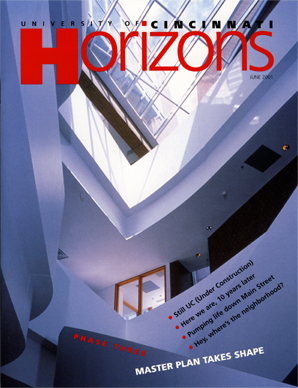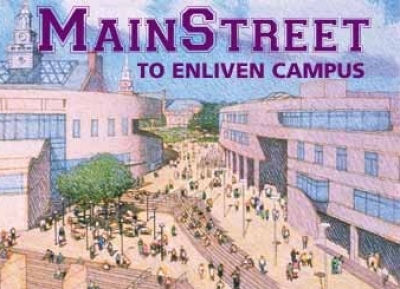By John Bach
Drive down Main Street of America's thriving small towns, and you'll notice a few common traits. Life is simple. Life is convenient. And life is everywhere. MainStreet is that bustling stretch where residents run their morning errands, share lunch-time meals and socialize throughout the evening. It is the place to see and be seen.
Now think of the University of Cincinnati as its own community. Though UC certainly has the population to make up its own town, it lacks the social energy of less populated communities. It lacks that bustling stretch of MainStreet. When classes are over, students get in their cars and drive home. Even dorm residents head off campus to grab a bite and relax with friends. UC on afternoons and weekends can look more like a ghost town than a college town. There is no common draw. No unifying reason for people to stick around.
UC's latest update to the Master Plan aims to change that. Up until now, the massive transformation of campus has involved building academic facilities, converting land into open green space and developing a pedestrian-friendly university. With those goals significantly complete, administrators have locked onto the fourth imperative of the Master Plan: "Quality of Campus Life and Student Services."
Last year the UC board of trustees committed to improving quality of life for students when it approved the largest infrastructure project in the history of the university. Appropriately named, the MainStreet project (slated to cost in the $200 millions and funded mostly by increased student fees) is a five-year undertaking that will result in a vibrant corridor running diagonally through the heart of West Campus, beginning near McMicken Hall and ending at the new Campus Green.
When current buildings are reconstructed, new buildings are erected and the pedestrian way is finished, the heart of campus life will beat along MainStreet. Lined with several new dining options, retail shops, suite-style student housing, cafes, top-of-the-line recreation facilities and modern offices for student organizations, MainStreet is a bold move by administrators to attract students and keep them on campus around the clock.
"It is not unlike trying to enliven a downtown," says Marc Petullo, an architect from UC's campus planning office. "You have to have services that are necessary and convenient to people. You have to provide places for people to live, to breathe. In essence, that is what we are doing here on campus."
University architect Ron Kull says the key to building a MainStreet that would rejuvenite campus life was approaching the project from a private-sector point of view.

 Past Issues
Past Issues